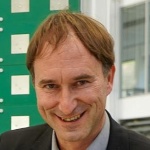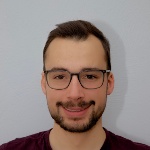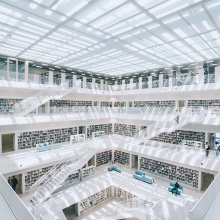The KT3.1 Workshop
The Workshop on "Modelling and simulation of photonic components" is a yearly event, bringing together researchers in optical communications to discuss recent research findings in an informal setting. This year it will be hosted by the Institute of Telecommunications (Nachrichtenübertragung) at the University of Stuttgart, marking the first time over the past 10 years or so that this workshop is to take place in Stuttgart.
Workshop dates
The two day workshop will be held on February 20 and 21, 2024 in the Institute of Telecommunications' own Shannon lecture hall (room PW47 2.314).
Information on how to get to the University/Institute of Telecommunications can be found further below.
Information for Visitors
The workshop is open and can be attended without prior registration.
Information for participants
Please bring your slides (pdf) on a USB stick along to the workshop or send them in advance to Sebastian Jung. Of course you can also use your own device for the presentation (via HDMI).
Workshop Schedule (TBD)
February 20
|
13:30 |
Begrüßung |
| 13:40 - 15:00 | Session I: Transmission technology |
|
„WDM bandwidth and EDFA power efficiency for SDM subsea transmissions“, Aymeric Arnould, Ronald Freund, Georg Rademacher, HHI |
|
| „Laser phase stabilization with external endless phase shifter“, P. R. Castro Ayala | |
| „Investigation of EDFA induced phase variations“, Ukiwo Anya, Adtran | |
| „Experimental and Simulative Analysis of Noise in an Electrical and Optoelectronic Coherent Terahertz Communication Systems for Long Distance High Data Rate Communication“, Joel Dittmer, Sebastian Randel, KIT | |
|
15:00 - 15:20 |
Coffee break |
|
15:20 - 16:20 |
Session II: Signal processing for optical |
|
„Spiking Neural Network Equalizer with Time-to-First-Spike Decoding for IM/DD Optical Communication“, Shuangxu Li, G. Böcherer, L. Schmalen, Huawei |
|
|
„Comparison of Feedback and Feedforward Digital Clock Recoveries for Optical Transmission“, Patrick Matalla*, Sebastian Randel, KIT |
|
|
„Neural Network Equalizers and Successive Interference Cancellation for Bandlimited Channels with a Nonlinearity“, Daniel Plabst, TUM |
|
| 16:20 - 16:45 | Coffee Break |
| 16:45 - 17:15 | Session III: Coding for optical |
| „Generalized Staircase Codes – the next step in coding for optics?“, Tim Janz, Uni Stuttgart | |
| 19:00 |
Möglichkeit zu einem gemeinsamen Abendessen |
|
Sophie's Brauhaus |
February 21
|
9:00-11:00 |
Session IV: Free space optics, satellite, and simulation experiments |
| „Electronic system design for small satellite optical communication terminals“, Christopher Schmidt, DLR | |
| „Simulation of Terrestrial Free-Space Optical Communication Links under Atmospheric Turbulence“, Jonas Krimmer | |
| „Simulative Analysis of Temperature Variation Measurements using Coherent Correlation Optical Time Domain Reflectometry (CC-OTDR)“, Tobias Philipp, Annika Dochhan, Stephan Pachnicke | |
| „Continuous-Variable Quantum Key Distribution over Varying Operating Distances“, Jonas Berl | |
|
10:40-11:00 |
Coffee break |
| 11:00-12:00 | Session V: Hardware components |
| „Entwicklung und Charakterisierung eines Erbium-dotierten Glasfasersensors zur Temperaturmessung“, Roman Kruglov | |
| "Gitterkoppler als opto-fluidische Schnittstelle", Rouven Klenk, Christian Schweikert, Niklas Hoppe, Wolfgang Vogel und Georg Rademacher | |
| „Verbesserung des Effizienz-Bandbreiten-Tradeoffs eines perfekt vertikalen Gitterkopplers in der 220 nm Silizium-auf-Isolator Technologie“, Christian Schweikert, Simon Nau, Niklas Hoppe, Wolfgang Vogel, Manfred Berroth, und Georg Rademacher | |
| 12:00-12:15 | Discussion, wrap-up, concluding remarks |
Stuttgart
<wikipedia> Stuttgart (pronounced SHTUUT-gart) is the capital and largest city of the German state of Baden–Württemberg. Stuttgart is located on the Neckar river in a fertile valley known locally as the „Stuttgart Cauldron”. It lies an hour from the Swabian Jura and the Black Forest. Its urban area has a population of 609,219, making it the sixth largest city in Germany. 2.7 million people live in the city’s administrative region and another 5.3 million people in its metropolitan area, making it the fourth largest metropolitan area in Germany.</wikipedia>
Some major companies have their headquarters in Stuttgart, including Porsche, Bosch, Mercedes–Benz,and Daimler.
Several European airlines have direct flights to Stuttgart International Airport from different European cities.
Venue
The workshop will be held in the Shannon Lecture Hall (room PW47 2.314) of the Institute of Telecommunications (INÜ).
A regional train station (named "Universität") is located right on campus (next to building PW47) with direct connections to Stuttgart International Airport, Stuttgart Main Station, the Mercedes–Benz Museum, and the downtown area.
Getting to the the Institute of Telecommunications
By Train
From Stuttgart Central Station with the train S1 (Herrenberg/Böblingen/Vaihingen), S2 (Filderstadt/Flughafen/Vaihingen) or the S3 (Flughafen/Vaihingen) to the stop 'Universität'. Exit the station through the 'Universitätszentrum' exit. Look around for the underpass. Walk through it and take the wide ramp on the left in order to access buidling PW47. The institute is on the second floor.
By Plane
From the airport, with the train S2 or S3 going in the direction 'Stadtmitte' to the stop 'Universität' (Travel time: 17 minutes). Exit the station through the 'Universitätszentrum' exit. Look around for the underpass. Walk through it and take the wide ramp on the left in order to access buidling PW47. The institute is on the second floor.
By Car
Take Highway A831 from the Stuttgart interchange in the direction Stuttgart-Vaihingen/Stuttgart-Zentrum. Exit the highway at 'Universität'. Enter the address "Pfaffenwaldring 43" into your navigator and park your car on one of the parking lots at this address. Do not enter Pfaffenwaldring 47 (wrong institute, Institut für Strahlwerkzeuge) but follow the path beyond the bar until its end. Take a right and take the wide ramp on the right in order to access building PW47. The institute is on the second floor.
Accomodation
Options are be the Hotel Pullman Stuttgart Fontana or, if you prefer a downtown accomodation, the Mariott Le Méridien. All hotels are conveniently located next to regional train stations connecting the university campus with downtown and the international airport.
Organizers

Stephan ten Brink
Prof. Dr.-Ing.Director

Sebastian Jung, M.Sc.
Research Assistant
Tim Janz, M.Sc.
Research Assistant



